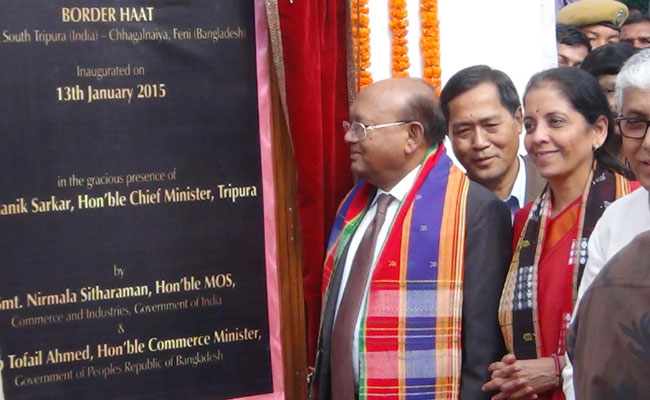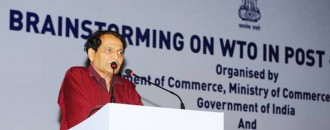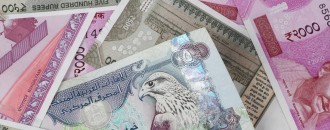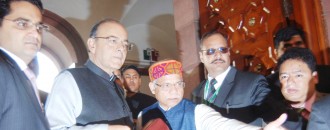
India-Bangladesh break barriers for trade across borders
 Smt. Nirmala Sitharaman, MoS for Commerce & Industry (IC), along with CM of Tripura, Shri Manik Sarkar and Mr. Tofail Ahmed, Commerce Minister of Bangladesh, at the inauguration of the Border Haat, in Srinagar, Tripura on January 13, 2015. The border haat was the third on the India-Bangladesh border. DGFT on June 4, 2015, notified the opening of the fourth border haat on the Indo-Bangladesh border at Kamalasagar (Tripura), which will be jointly inaugurated by India's PM Narendra Modi and Bangladesh's Premier Sheikh Hasina, expectedly on June 6, 2015, through video conferencing from Dhaka.
Smt. Nirmala Sitharaman, MoS for Commerce & Industry (IC), along with CM of Tripura, Shri Manik Sarkar and Mr. Tofail Ahmed, Commerce Minister of Bangladesh, at the inauguration of the Border Haat, in Srinagar, Tripura on January 13, 2015. The border haat was the third on the India-Bangladesh border. DGFT on June 4, 2015, notified the opening of the fourth border haat on the Indo-Bangladesh border at Kamalasagar (Tripura), which will be jointly inaugurated by India's PM Narendra Modi and Bangladesh's Premier Sheikh Hasina, expectedly on June 6, 2015, through video conferencing from Dhaka.Come June 6 and Tripura’s Kamalasagar would be bustling with trade activities, thanks to the new ‘border haat’ (border market) that will be inaugurated in state’s Sipahijala district, which borders Brahmanbaria district of Bangladesh, to boost bilateral trade between India and the neighbouring country. The Commerce Ministry permitted trading of locally-produced goods in border haats at Kamalasagar in Tripura and Tarapur Kasba in the neighbouring country. Once inaugurated, the border haat in Kamalasagar, 30 km south-west of Agartala, will be the second in the state and the fourth along the India-Bangladesh border. The haats will give the locals a platform to boost their trade. The trading community in the state is all excited about the development since the opening of the haat will not only encourage people-to-people contacts but will also create economic opportunities. “The small-time traders are hoping to get a boost to their business after the opening up of the border haat,” says Shyamal Kanti Dev, General Manager of the Tripura Industrial Development Corporation, which is the nodal agency for setting up border haats. The opening of the fourth haat is being seen as a significant move ahead of Prime Minister Narendra Modi’s visit to Dhaka, where he will jointly inaugurate the border haat with her Bangladeshi counterpart Sheikh Hasina through conferencing. As per the arrangements made by the Director General of Foreign Trade under the Memorandum of Understanding (MOU) between India and Bangladesh, business in the haat would take place once a week among the people living within 5 km radius of the border who would sell and buy locally produced goods and crops. The DGFT has enlisted 16 commodities which will be allowed to be traded in the haat, where people of both the countries can participate in trading on designated days and time every week. These items include locally produced vegetables, food items, fruits, spices; minor local forest produce -- bamboo, bamboo grass and broom stick but excluding timber; products of local cottage industries like gamcha and lungi; locally produced small agricultural household implements -- plough, axe, spade and chisel. The trading community in Tripura is anticipating good business at the haat on account of its proximity with the state capital. “The state’s first border haat witnessed a bilateral trade worth Rs 84 lakhs in first three months of its inauguration. This, when it was about 140 kms from Agartala. And opening of the market which is just 30 kms from the state capital will enable good business,” adds Dev. Upbeat with the response received in the haat at Srinagar in South Tripura, the traders are hopeful of doing more business. “There was an overwhelming response to the haat. The traders from both the sides showed interests in the goods of either countries. The success of border haat at Srinagar can be gauged from the fact that India recorded business worth Rs 58 lakhs and Bangladesh witnessed trading activities worth Rs 26 lakhs within three months of opening of the market.” “There has been increasing demand of Indian textiles from Bangladeshi traders and Indian traders also expressed good interest in food items from the neighbouring country. The opening of the border haat will surely give a boost to these sectors,” Dev maintained. History has it that border haats in Meghalaya were functional even during the Mughal period. Once known to be the thriving centres of trade and commerce along the border, the Mughal-era haats were shut down after the creation of Bangladesh in 1971. It was only after four decades, that the border trade was revived when a MoU was inked between the two countries. India and Bangladesh in October 2010, had signed a MoU to promote border trade through two new haats at Kamalasagar, Tripura and Tarapur Kasba on Bangladesh side. Since then, four border haats have been opened along the border of the two countries. Two border haats were set up in 2012, on the Meghalaya sector of Indo-Bangladesh border - one at Kalaichar in Meghalaya`s West Garo Hills district and Baliamari of Bangladesh`s Kurigram district, and another in Balat (in East Khasi Hills district) and Lauwaghar (Dalora) in Bangladesh`s Sunamganj district. Earlier this year, Commerce and Industry Minister Nirmala Sitharaman had jointly inaugurated Tripura's first 'border haat' in Srinagar - about 140 km south of state capital Agartala. India is keen to set up 70 border markets along its border with Bangladesh, says a Union Home Ministry report. The Tripura government had proposed to set up eight border haats, however, it was agreed to set up only four. The state governments of Manipur, Nagaland, Arunachal Pradesh and Mizoram have also proposed the setting up of 15 'border haats' along the India-Myanmar border to develop trans-border trade and business. India shares a 4,096-km border with Bangladesh along West Bengal, Tripura , Assam, Meghalaya and Mizoram. India also has a border trade with Myanmar through Moreh in Manipur.
June 04, 2015 | 6:49 pm IST.





 to success.
to success.